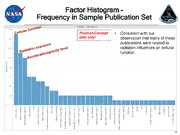
NASA Technical Reports Server (NTRS) 20150000536: Concepts to Support HRP Integration Using Publications and Modeling PDF
Preview NASA Technical Reports Server (NTRS) 20150000536: Concepts to Support HRP Integration Using Publications and Modeling
National Aeronautics and Space Administration Concepts to Support HRP Integration Using Publications and Modeling Jennifer Mindock Sarah Lumpkins Mark Shelhamer January 15, 2015 1 Introduction HRP’s role: enabling safe, reliable, and productive human space exploration within and beyond Low Earth Orbit. Can we increase effectiveness of addressing the risks of getting humans to Mars? With limited flight resources, can we provide • countermeasures • knowledge • technologies • and tools that take advantage of multiple perspectives, disciplines, and complementary solutions? As seen in previous talk, initial efforts are underway to enhance HRP’s emphasis on integration and cross-disciplinary scientific collaborations. 2 Use Models and Tools to Support Integration To emphasize integration in HRP’s science portfolio management, concepts are being explored through development of a set of tools. These tools are intended to enable modeling, analysis, and visualization of • the state of the human system in the spaceflight environment • HRP’s current understanding of that state with an indication of uncertainties • and how that state changes due to HRP programmatic progress and design reference mission definitions. Image from: http://zerog2002.de/bodyreactions.html 3 Initial High-Level Model Framework Common goals of safe, productive and reliable human space flight Whether focus is on Operations, Vehicle Design or the Human System Operations Vehicle Design Arrows represent influences Human Task Performance Outcomes Mission Outcomes 4 Expanding Framework In the Human System, HRP supports the protection of additional outcomes Operations Vehicle Design Human Behavioral Health and Cognition Outcomes Physiological Performance Outcomes Physical Health Outcomes Task Performance Outcomes Mission Outcomes 5 5 6 6 “CFM” 7 7 Initial Questions Driving Modeling Approach Risk Level • Characterization of Work: What Risks are being addressed? • Completeness/Scope: Have related Risks been adequately addressed in Evidence Reports? In Research Plans (Gaps and Tasks)? • Collaborations: For the Research Plans of related Risks, are there potential collaborations or efforts with information that could be shared? Factor Level • Characterization of Work: What factors are being addressed? • For factors that appear influential or high priority (e.g., based on frequency in a relevant search, a sensitivity analysis per Risk, DRM, mission phase…) • Completeness/Scope: Have those factors been adequately addressed in Evidence Reports? In Research Plans (Gaps and Tasks)? • Collaborations: For Risks with the same relevant factors, are there potential collaborations or efforts with information that could be shared? 8 Model for Integration – Information Interface Concepts HSRB Risk HRP IRP Summaries Human System Model (based on CFM framework) Domain- Scientific Specific Publications Models Visualization Focused Analysis Tools Tool 9 Initial Integration Activities Human System Model Scientific Publications (based on CFM framework) Model the Human/Vehicle/Ops Collect publications sponsored by System framework (long term: and related to) HRP research Model factor relationships, Tag ERs and publications strengths of relationships, etc. with factors and risks Analyze database Analyze model content content Visualization Tool Visualize analysis results 10
